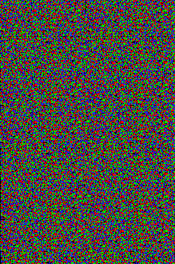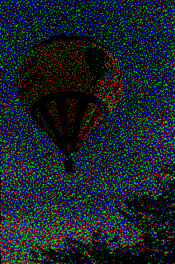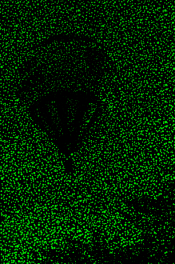The colour that you see when looking at an autochrome is the light that passes through the developed film and through the filter in front of the emulsion.
Here's my simulation of the colour filter, which is bits of dyed starch, with the interstitial voids filled with carbon black. The starch grains are little filters, which act similarly to the Bayer filter in front of digital sensors:

This colour screen is used twice: first in front of the film during exposure, and then again in front of the film for viewing.
During exposure, the filter only allows of a certain colour to reach the emulsion directly behind it.
The film is then reversal processed, to give a positive black and white image. Consider what it means for an image to be a positive: where the light has struck the emulsion, the developed film is transparent. Likewise, where no light has struck the emulsion, the developed film is opaque/black.
Finally, the original colour screen used during exposure is sandwiched to the film, in register. Light from behind the autochrome passes through the transparent parts of the film (i.e. the exposed parts of the film), and through the filter.
~~~~~
Here's a specific example. Consider the following scene of a hot air balloon:

Here's what the finished autochrome might look like:

On the yellow part of the balloon, there is almost no reflected blue light (that's why it appears yellow, yellow is the anti-blue!). Thus any blue-dyed starch grain which lies atop the yellow part of the balloon will block the light, the emulsion will not be exposed, and therefore the developed film behind the blue filters on the balloon will be opaque. Then, when you look at the finished autochrome, no blue light will pass through the developed film in this part of the image.
However, recall that yellow light is a linear combination of red and green light (or at least as human eyes perceive it!) Thus, some of the yellow light will pass through the red-dyed starch grains and the green-dyed starch grains, exposing the emulsion beneath, and thereby making the film clear in those areas after development. When you look at the yellow balloon on the finished autochrome, light will pass backwards through those clear areas of the film and through the respective red and green filters. We perceive this combination of red and green light as yellow.
It might help to see the individual RGB channels of the autochrome. Note that the balloon appears black in the blue channel, but is lighter coloured in the red and green channels:



~~~~
Finally, to answer your question. "Unsensitized" silver halide emulsions are mostly sensitive to near-UV, with a bit of sensitivity extending into the visible spectrum (depending on the halide used). If you used an unsensitized emulsion with a red filter, the film would not be exposed. Although red photons are hitting the film, the film cannot form a latent image.
A panchromatic emulsion, is a regular B&W silver halide emulsion to which sensitizing dyes have been added. These dyes increase the spectral sensitivity of the film into the visible spectrum. Co-incidentally, they are likely to impart a colour to the emulsion, but this is not the reason for adding the dyes. Most dye washes out during development.



















